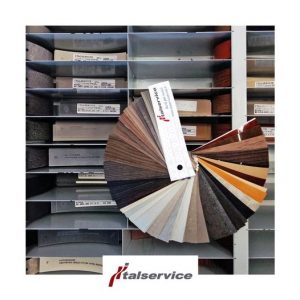A bit of history
The edge mainly used on the current market is in ABS (Acrylonitrile Butadiene Styrene), a common thermoplastic polymer used worldwide to create objects of various sizes and functionality, characterized by its excellent resistance to thermo-variationsimpact and hardness.
Its excellent mechanical properties, make ABS an extremely flexible and easily workable product, also able to maintain a consistent color and shape. It is also a technically recyclable material that does not include pure halogens in its formulation and is made using the ultraviolet (UV) coating method to provide greater gloss and surface strength.

The PVC board instead is composed of a plastic material called polyvinyl chloride. It is on a different market than ABS in that it is a cheaper product and therefore has greater rigidity and lower resistance to high temperatures.
Alternatively, depending on the different uses, the market also suggests using edges made of other materials, including laminate, paper or single-layer.
The laminate edge is made from kraft paper, impregnated with melamine resins and has a smooth, flexible and abrasion resistant surface. It is usually applied when a laminate panel, too, cannot opt for a plastic board.
The mainly used thickness is 0.40 mm. The main feature is the high heat resistance but on the contrary, it can present some problems of tightness at low temperatures in case of use in extremely rigid periods withou respecting the necessary laying procedures.
To overcome this inconvenience, it is possible to use a paper or monolayer edge that does not show problems related to the climatic temperatures during application.
There is also a wooden edge in the range, which is actually the most versatile product and can be used when the matching panel is plated. Its versatility lies in being able to layer several edges glued one on top of the other, until you get to the desired thickness. This action, especially on the curved sides, allows you to create a real solid, on which you can work creating incisions or grooves.
